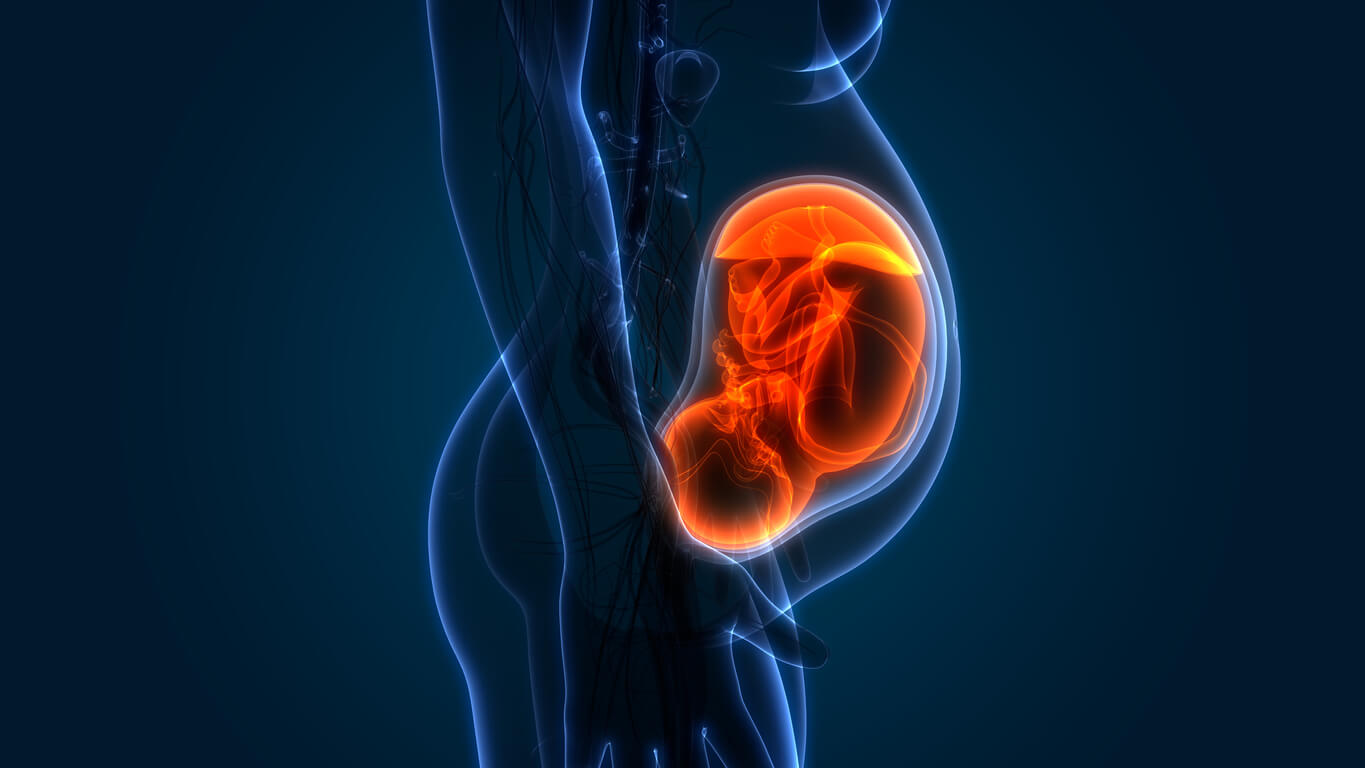How to Maintain a Healthy Placenta?


Written and verified by the nurse Leidy Mora Molina
Maintaining a healthy placenta is a necessity during pregnancy, as this organ allows the baby’s well-being and strengthens it so it can grow inside the uterus. Now, what should a mother do to keep this tissue healthy during pregnancy?
The placenta is only present in the uterus during pregnancy. In the following article, we’ll tell you about its characteristics, its functions during pregnancy, what habits can affect this tissue, and how to keep it healthy.
What is the placenta?
When a woman becomes pregnant, her body begins a perfect transformation and creates new cells and tissues that allow it to give life to the new being. To do this, it creates the placenta, an organ that’s attached to the inner walls of the uterus and is formed to keep the baby alive and connect it to the mother. Its functions are vital, and we’ll highlight some of them below.
Oxygenating the baby
The placenta is connected to the baby by the umbilical cord. There are two umbilical arteries and a vein in the umbilical cord, whose function is to carry oxygen to the baby through the mother’s circulation and to eliminate carbon dioxide. This occurs because the baby inside the uterus is surrounded by amniotic fluid and its lungs can’t take in air. Therefore, its oxygenation is only possible through the placenta.
Providing nutrients
The placenta serves as a means of transport for the passing of nutrients to the fetus from what the mother ingests. Vitamins, minerals, proteins, fatty acids, and glucose reach the fetus through the placenta. In this way, they enable the formation of its cells and the strengthening of the baby’s organs and tissues.
Excreting waste
Through the placenta, waste and excess fluid are eliminated from the baby’s body. This organ acts as a filter and discards all substances that may be dangerous in your body. This occurs through the umbilical cord, as all waste passes from fetal circulation to the mother and from there to the kidneys, to finally be excreted.

Secreting hormones
The placenta is also responsible for the secretion of hormones that help regulate all the processes of pregnancy and childbirth. Therefore, it performs its functions both in the uterus and in other parts of the body. Among these we can highlight the following:
- Human Chorionic Gonadotropin
- Placental Lactogen
- Progesterone
- Estradiol
Creating a protective barrier
The placenta protects the baby from external microorganisms, such as bacteria, viruses, and parasites. It also prevents the maternal immune system from identifying the baby as a foreign body and attacking it.
Characteristics of a healthy placenta
A healthy placenta is one that fulfills all the functions described above, in addition to being located in the right place and well attached to the uterus. These are some of its characteristics:
- It has a discoidal shape.
- Its weight is approximately 18 ounces.
- Its average diameter is 8 inches.
- Its thickness is 1.75 to 2.25 inches.
- The umbilical cord is inserted into it. It’s considered normal to measure around 55 centimeters.
The placenta can be affected by certain factors, such as the mother’s age, high blood pressure in the mother, multiple pregnancies, premature rupture of membranes, coagulation problems, placental problems, and smoking habits, among others.
Keeping the placenta healthy
Just as we take care of our heart, lungs, and stomach, we must also be careful to keep the placenta healthy during pregnancy. If this organ is healthy, the baby will also be healthy, as it will have the right weight and enjoy good health. For this, it’s essential for the mother to take measures that promote the good performance of the temporary tissue. Here are some tips on how to do this.
Stay hydrated
Good hydration helps maintain the health of the placenta. This happens because it increases the blood volume and, in this way, maintains adequate oxygenation and allows the transport of oxygen to the baby.
Eat healthy
For the correct formation of the placenta, it’s essential that the body provides it with enough vitamins and minerals that allow cell multiplication and tissue formation. For this, rely on foods such as vegetables, fruits, legumes, proteins, and nuts, as well as the vitamin supplements indicated by a specialist. Avoid processed foods and those that are forbidden during pregnancy.

Exercise
Exercising during pregnancy is very appropriate, as it allows all organs to function properly. Exercises should be gentle, so the most recommended at this stage are swimming, yoga, and prenatal pilates.
Avoid harmful habits
Drinking alcohol, smoking, or sleeping too little are all habits that alter the proper functioning of the placenta. These habits can affect the placenta or cause it to age prematurely, that is, before the last month of pregnancy. Consequently, an aged placenta won’t provide the oxygen or nutrients necessary for the health of the baby and will increase the risk of premature births or low birth weight.
Stress can cause alterations such as high blood pressure, which in turn influences the contraction of the placental blood vessels and the correct supply of oxygen. Likewise, it has been shown that, through this organ, maternal stress hormones pass to the baby, so the baby may also feel tired and nervous. For this reason, it’s also a good idea to carry out activities such as mindfulness or relaxing massages.
Healthy habits and a proper diet
As we saw, the placenta is a transitory tissue present only during pregnancy. Through it, the baby is kept alive and strengthened inside the uterus. However, like any other organ, it must be cared for by maintaining healthy habits and a balanced diet.
Maintaining a healthy placenta is a necessity during pregnancy, as this organ allows the baby’s well-being and strengthens it so it can grow inside the uterus. Now, what should a mother do to keep this tissue healthy during pregnancy?
The placenta is only present in the uterus during pregnancy. In the following article, we’ll tell you about its characteristics, its functions during pregnancy, what habits can affect this tissue, and how to keep it healthy.
What is the placenta?
When a woman becomes pregnant, her body begins a perfect transformation and creates new cells and tissues that allow it to give life to the new being. To do this, it creates the placenta, an organ that’s attached to the inner walls of the uterus and is formed to keep the baby alive and connect it to the mother. Its functions are vital, and we’ll highlight some of them below.
Oxygenating the baby
The placenta is connected to the baby by the umbilical cord. There are two umbilical arteries and a vein in the umbilical cord, whose function is to carry oxygen to the baby through the mother’s circulation and to eliminate carbon dioxide. This occurs because the baby inside the uterus is surrounded by amniotic fluid and its lungs can’t take in air. Therefore, its oxygenation is only possible through the placenta.
Providing nutrients
The placenta serves as a means of transport for the passing of nutrients to the fetus from what the mother ingests. Vitamins, minerals, proteins, fatty acids, and glucose reach the fetus through the placenta. In this way, they enable the formation of its cells and the strengthening of the baby’s organs and tissues.
Excreting waste
Through the placenta, waste and excess fluid are eliminated from the baby’s body. This organ acts as a filter and discards all substances that may be dangerous in your body. This occurs through the umbilical cord, as all waste passes from fetal circulation to the mother and from there to the kidneys, to finally be excreted.

Secreting hormones
The placenta is also responsible for the secretion of hormones that help regulate all the processes of pregnancy and childbirth. Therefore, it performs its functions both in the uterus and in other parts of the body. Among these we can highlight the following:
- Human Chorionic Gonadotropin
- Placental Lactogen
- Progesterone
- Estradiol
Creating a protective barrier
The placenta protects the baby from external microorganisms, such as bacteria, viruses, and parasites. It also prevents the maternal immune system from identifying the baby as a foreign body and attacking it.
Characteristics of a healthy placenta
A healthy placenta is one that fulfills all the functions described above, in addition to being located in the right place and well attached to the uterus. These are some of its characteristics:
- It has a discoidal shape.
- Its weight is approximately 18 ounces.
- Its average diameter is 8 inches.
- Its thickness is 1.75 to 2.25 inches.
- The umbilical cord is inserted into it. It’s considered normal to measure around 55 centimeters.
The placenta can be affected by certain factors, such as the mother’s age, high blood pressure in the mother, multiple pregnancies, premature rupture of membranes, coagulation problems, placental problems, and smoking habits, among others.
Keeping the placenta healthy
Just as we take care of our heart, lungs, and stomach, we must also be careful to keep the placenta healthy during pregnancy. If this organ is healthy, the baby will also be healthy, as it will have the right weight and enjoy good health. For this, it’s essential for the mother to take measures that promote the good performance of the temporary tissue. Here are some tips on how to do this.
Stay hydrated
Good hydration helps maintain the health of the placenta. This happens because it increases the blood volume and, in this way, maintains adequate oxygenation and allows the transport of oxygen to the baby.
Eat healthy
For the correct formation of the placenta, it’s essential that the body provides it with enough vitamins and minerals that allow cell multiplication and tissue formation. For this, rely on foods such as vegetables, fruits, legumes, proteins, and nuts, as well as the vitamin supplements indicated by a specialist. Avoid processed foods and those that are forbidden during pregnancy.

Exercise
Exercising during pregnancy is very appropriate, as it allows all organs to function properly. Exercises should be gentle, so the most recommended at this stage are swimming, yoga, and prenatal pilates.
Avoid harmful habits
Drinking alcohol, smoking, or sleeping too little are all habits that alter the proper functioning of the placenta. These habits can affect the placenta or cause it to age prematurely, that is, before the last month of pregnancy. Consequently, an aged placenta won’t provide the oxygen or nutrients necessary for the health of the baby and will increase the risk of premature births or low birth weight.
Stress can cause alterations such as high blood pressure, which in turn influences the contraction of the placental blood vessels and the correct supply of oxygen. Likewise, it has been shown that, through this organ, maternal stress hormones pass to the baby, so the baby may also feel tired and nervous. For this reason, it’s also a good idea to carry out activities such as mindfulness or relaxing massages.
Healthy habits and a proper diet
As we saw, the placenta is a transitory tissue present only during pregnancy. Through it, the baby is kept alive and strengthened inside the uterus. However, like any other organ, it must be cared for by maintaining healthy habits and a balanced diet.
All cited sources were thoroughly reviewed by our team to ensure their quality, reliability, currency, and validity. The bibliography of this article was considered reliable and of academic or scientific accuracy.
- Morgan F. (2015). Anatomía y fisiología de la placenta y líquido amniótico. México. Rev Med UAS; Vol. 5: No. 4. Septiembre-Diciembre 2015
- Rodríguez Y. (2014). La placenta como órgano endocrino compartido y su acción en el embarazo normoevolutivo. Revista de medicina e investigación. Vol 2. Num. 1.
This text is provided for informational purposes only and does not replace consultation with a professional. If in doubt, consult your specialist.








